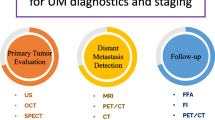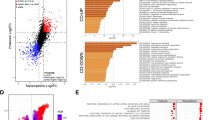Abstract
Ocular adnexal extranodal marginal zone lymphoma (OA-EMZL) is the most frequent subtype of ocular adnexal lymphoma, with a high propensity for recurrence. Distant recurrence (DR) as an essential prognostic event has unique clinical risk factors, but whether distinct molecular features exist remains poorly understood. Here, we identified potential biomarkers using proteomic analysis of 27 OA-EMZL samples. The MYC-targeted genes PCNA, MCM6, and MCM4 were identified as candidates. MYC-targeted genes were further identified as the most significantly activated gene set in patients with DR. The candidate genes were verified in samples from 11 patients with DR and 33 matched controls using immunohistochemistry. The 3-year and 5-year AUC values of MCM6 (0.699 and 0.757) were higher than those of Ki-67 (0.532 and 0.592). High expressions of MCM6 and MCM4 were significantly associated with shorter distant recurrence–free survival (Log-rank p = 0.017, Log-rank p = 0.0053). Multivariate Cox regression identified MCM6 expression as an independent risk factor for DR (HR, 6.86; 95% CI, 1.32–35.79; P = 0.02). Knockdown of c-Myc in B cells resulted in decreased MCM6 and MCM4 expression and reduced proliferative capacity. Our results suggest that activation of the MYC-targeted gene is a distinct molecular feature of DR in OA-EMZL. MYC-targeted gene, MCM6, is a promising pathological biomarker for DR.




Similar content being viewed by others
Data availability
The data used to support the findings of this study are available from the corresponding author upon request.
References
Di Rocco A, Petrucci L, Assanto GM, Martelli M, Pulsoni A (2022) Extranodal marginal zone lymphoma: pathogenesis, diagnosis and treatment. Cancers (Basel) 14:1742
Nakamura S, Ponzoni M (2020) Marginal zone B-cell lymphoma: lessons from Western and Eastern diagnostic approaches. Pathology 52:15–29
Cerhan JR, Habermann TM (2021) Epidemiology of marginal zone lymphoma. Ann Lymphoma 5:1
Stefanovic A, Lossos IS (2009) Extranodal marginal zone lymphoma of the ocular adnexa. Blood 114:501–510
Ferry JA et al (2007) Lymphoma of the ocular adnexa: a study of 353 cases. Am J Surg Pathol 31:170–184
Cho EY et al (2003) Clinicopathologic analysis of ocular adnexal lymphomas: extranodal marginal zone b-cell lymphoma constitutes the vast majority of ocular lymphomas among Koreans and affects younger patients. Am J Hematol 73:87–96
Coupland SE (2013) Molecular pathology of lymphoma. Eye (Lond) 27:180–189
Wenzel C et al (2003) Extranodal marginal zone B-cell lymphoma of mucosa-associated lymphoid tissue of the head and neck area: high rate of disease recurrence following local therapy. Cancer 97:2236–2241
Suh C, Huh J, Roh JL (2008) Extranodal marginal zone B-cell lymphoma of mucosa-associated lymphoid tissue arising in the extracranial head and neck region: a high rate of dissemination and disease recurrence. Oral Oncol 44:949–955
Shi J et al. (2022) Predicting the risk of distant and local recurrence for patients with ocular adnexal extranodal marginal zone lymphoma: a matched case-control study. Br J Ophthalmol. https://doi.org/10.1136/bjo-2022-321656
Lee J et al (2019) Long-term outcome, relapse patterns, and toxicity after radiotherapy for orbital mucosa-associated lymphoid tissue lymphoma: implications for radiotherapy optimization. Jpn J Clin Oncol 49:664–670
Ohga S et al (2015) Treatment Outcome of Radiotherapy for Localized Primary Ocular Adnexal MALT Lymphoma-Prognostic effect of the AJCC tumor-node-metastasis clinical staging system. Anticancer Res 35:3591–3597
Carbone PP, Kaplan HS, Musshoff K, Smithers DW, Tubiana M (1971) Report of the committee on Hodgkin’s disease staging classification. Cancer Res 31:1860–1861
Shi J et al (2022) Proteotranscriptomics of ocular adnexal B-cell lymphoma reveals an oncogenic role of alternative splicing and identifies a diagnostic marker. J Exp Clin Cancer Res 41:234
Gerdes J (1990) Ki-67 and other proliferation markers useful for immunohistological diagnostic and prognostic evaluations in human malignancies. Semin Cancer Biol 1:199–206
Lüscher B, Larsson LG (1999) The basic region/helix-loop-helix/leucine zipper domain of Myc proto-oncoproteins: function and regulation. Oncogene 18:2955–2966
Schick M, Habringer S, Nilsson JA, Keller U (2017) Pathogenesis and therapeutic targeting of aberrant MYC expression in haematological cancers. Br J Haematol 179:724–738
Lin X et al (2017) C-myc overexpression drives melanoma metastasis by promoting vasculogenic mimicry via c-myc/snail/Bax signaling. J Mol Med (Berl) 95:53–67
Wolfer A, Ramaswamy S (2011) MYC and metastasis. Cancer Res 71:2034–2037
Nguyen L, Papenhausen P, Shao H (2017) The role of c-MYC in B-cell lymphomas: diagnostic and molecular aspects. Genes (Basel) 8:116
Dang CV (1999) c-Myc target genes involved in cell growth, apoptosis, and metabolism. Mol Cell Biol 19:1–11
Robson S, Pelengaris S, Khan M (2006) c-Myc and downstream targets in the pathogenesis and treatment of cancer. Recent Pat Anticancer Drug Discov 1:305–326
Komiya K et al (2010) Mina53, a novel c-Myc target gene, is frequently expressed in lung cancers and exerts oncogenic property in NIH/3T3 cells. J Cancer Res Clin Oncol 136:465–473
Komiya K et al (2010) Expression of Mina53, a novel c-Myc target gene, is a favorable prognostic marker in early stage lung cancer. Lung Cancer 69:232–238
Ishizaki H et al (2007) Overexpression of the myc target gene Mina53 in advanced renal cell carcinoma. Pathol Int 57:672–680
**a P et al (2021) MYC-targeted WDR4 promotes proliferation, metastasis, and sorafenib resistance by inducing CCNB1 translation in hepatocellular carcinoma. Cell Death Dis 12:691
Ahmed OM, Ma AK, Ahmed TM, Pointdujour-Lim R (2020) Epidemiology, outcomes, and prognostic factors of orbital lymphoma in the United States. Orbit 39:397–402
Broyde A et al (2009) Role and prognostic significance of the Ki-67 index in non-Hodgkin’s lymphoma. Am J Hematol 84:338–343
Hoster E et al (2016) Prognostic value of Ki-67 index, cytology, and growth pattern in mantle-cell lymphoma: results from randomized trials of the european mantle cell lymphoma network. J Clin Oncol 34:1386–1394
Bravo R, Fey SJ, Bellatin J, Larsen PM, Celis JE (1982) Identification of a nuclear polypeptide (“cyclin”) whose relative proportion is sensitive to changes in the rate of cell proliferation and to transformation. Prog Clin Biol Res 85(Pt A):235–248
Alison MR, Hunt T, Forbes SJ (2002) Minichromosome maintenance (MCM) proteins may be pre-cancer markers. Gut 50:290–291
Ishimi Y et al (2003) Enhanced expression of Mcm proteins in cancer cells derived from uterine cervix. Eur J Biochem 270:1089–1101
Hunt DP et al (2002) Early recurrence of benign meningioma correlates with expression of mini-chromosome maintenance-2 protein. Br J Neurosurg 16:10–15
Ramnath N et al (2001) MCM2 is an independent predictor of survival in patients with non-small-cell lung cancer. J Clin Oncol 19:4259–4266
Kodani I et al (2003) Minichromosome maintenance 2 expression is correlated with mode of invasion and prognosis in oral squamous cell carcinomas. J Oral Pathol Med 32:468–474
Gonzalez MA et al (2004) Geminin predicts adverse clinical outcome in breast cancer by reflecting cell-cycle progression. J Pathol 204:121–130
Schrader C et al (2005) Minichromosome maintenance protein 6, a proliferation marker superior to Ki-67 and independent predictor of survival in patients with mantle cell lymphoma. Br J Cancer 93:939–945
Ho L et al (2005) MALT1 and the API2-MALT1 fusion act between CD40 and IKK and confer NF-kappa B-dependent proliferative advantage and resistance against FAS-induced cell death in B cells. Blood 105:2891–2899
Honma K et al (2008) TNFAIP3 is the target gene of chromosome band 6q23.3-q24.1 loss in ocular adnexal marginal zone B cell lymphoma. Genes Chromosomes Cancer 47:1–7
Funding
This work was supported by Innovative Research Team of High-Level Local Universities in Shanghai (SHSMU-ZDCX20210902), The Science and Technology Commission of Shanghai (20DZ2270800, 19JC1410200), and the Project of Biobank of Shanghai Ninth People’s Hospital, Shanghai Jiao Tong University School of Medicine (YBKA201907; YBKA202208).
Author information
Authors and Affiliations
Contributions
Conceptualization: Yixiong Zhou. Methodology: Tianyu Zhu, Jiahao Shi. Formal analysis and investigation: Tianyu Zhu, Jiahao Shi, **aowen Zhou. Writing—original draft preparation: Tianyu Zhu. Writing—review and editing: Tianyu Zhu, Jiahao Shi, Yixiong Zhou. Funding acquisition: Renbing Jia. Resources: Yefei Wang, **n Song, Yixiong Zhou. Supervision: Yefei Wang, **n Song, Yixiong Zhou.
Corresponding authors
Ethics declarations
Ethics approval and consent to participate
The research followed the tenets of the Declaration of Helsinki. The collection of the clinical and pathological information was approved by the institutional review board of Ninth People's Hospital, Shanghai Jiao Tong University School of Medicine (approval No. SH9H-2019T185-2).
Consent for publication
Not applicable.
Competing interests
The authors declare no competing interests.
Additional information
Publisher's note
Springer Nature remains neutral with regard to jurisdictional claims in published maps and institutional affiliations.
Supplementary Information
Below is the link to the electronic supplementary material.
277_2023_5203_MOESM2_ESM.pdf
Supplementary file2. (A) Time dependent ROC curves of PCNA on DRFS, LRFS and RFS.(B) Kaplan-Meier survival curves for LRFS and RFS by Ki-67, MCM6, and MCM4 expression (cut-off: median H-score).(C) DRFS and LRFS in patients with OA-EMZL and high or low expression of Ki-67, MCM6 and MCM4 (cut-off: AUC value). (PDF 659 KB)
277_2023_5203_MOESM3_ESM.pdf
Supplementary file3. (A), (B): The distribution of propensity scores of distant recurrence (treated) and non-distant recurrence (control) before and after matching clinical characteristics. (PDF 438 KB)
Rights and permissions
Springer Nature or its licensor (e.g. a society or other partner) holds exclusive rights to this article under a publishing agreement with the author(s) or other rightsholder(s); author self-archiving of the accepted manuscript version of this article is solely governed by the terms of such publishing agreement and applicable law.
About this article
Cite this article
Zhu, T., Shi, J., Zhou, X. et al. MYC-targeted genes predict distant recurrence in patients with ocular adnexal extranodal marginal zone lymphoma. Ann Hematol 102, 2413–2423 (2023). https://doi.org/10.1007/s00277-023-05203-8
Received:
Accepted:
Published:
Issue Date:
DOI: https://doi.org/10.1007/s00277-023-05203-8




